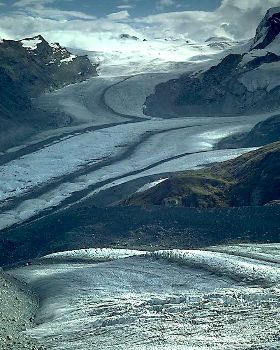by Larry
November, 2003From Snowball Earth to Arctic Turf
We sometimes take our world and its seasons, beautiful lands, seas, lakes, skies, and rivers for granted, as if things have always been and will forever be this way. Yet this orb has gone through many changes. They are happening still and, even within our lifetimes, or at least those of the next generation, are likely to bring dramatic transformations.
Not only once but several times in Terra's prehistory, conditions were far different than today, so pervasively cold that glaciers, snow-covered lands, and frozen seas swaddled essentially the entire globe, from the poles to the equator buried in ice. The only exceptions were tiny "islands" of liquid where local circumstances, such as hot springs, prevented the freezing from being absolute. What life there was probably prevailed through these snowball Earth phases solely because of a few such oases of relative warmth. Alterations in both solar radiation and our atmosphere eventually brought an end to those deep-freeze days, ushering in a time of cyclical seasons, explosive growths of fauna and flora, and the less severe big and little ice ages. That last major ice age began to thaw roughly 11,500 years ago. The last Little Ice Age occurred in the 19th Century, when Napoleon's army was decimated by the Russian winter, women regularly wore multi-layers not just for decorum or fashion but to keep warm, summers often came quite late, and the Thames, in London, would often freeze. Today, though, whether due to the natural sequence, as we continue to come out of that last little age of ice, or to man's intervention in the planet's absorption or reflection of the sun's rays, things are rapidly changing again, so fast, in fact, that in another decade or two most of the glaciers around when I was born may be gone. The arctic pack ice is already 40% thinner than three decades ago. Within a half-century or so, most of the poles may be ice- and snow-covered only in winter, the water melting again each following summer, just as now occurs in much of North America, Europe, and Asia. As the reduced ice caps reflect less sunlight back into space, the warming trend is likely to accelerate.
Many regions of permafrost are permanently frozen no longer, destabilizing some cities inside the Arctic Circle. The thawing peat in these areas has started to release multiple tons per year of additional greenhouse gases into our upper atmosphere. The arctic tundra is changing too, beginning to fill in with trees, shrubs, and other vegetation more typical of the former temperate zones. Soon such regions in the warmer seasons may sprout grasses such as now are seen in Ireland and Scotland. Greenland may then no longer be a misnomer. With these changes will arise other immense ones to plants, climate, the spread of pests and diseases, animals, and agriculture. The pendulum will have come to its full swing, from snowball Earth to arctic turf.
Snowball Earth. P.F. Hoffman, et al. In "Scientific American;" January 2000. Meltdown in the North. M. Sturm, et al. In "Scientific American," Vol. 289, No. 4, pp. 60-67; October 2003. |

 A long-sought practical northwest passage is now being planned for by commercial interests. It will connect the Atlantic and Pacific by a sea route north of the Canadian and Alaskan "frozen wastes."
A long-sought practical northwest passage is now being planned for by commercial interests. It will connect the Atlantic and Pacific by a sea route north of the Canadian and Alaskan "frozen wastes."